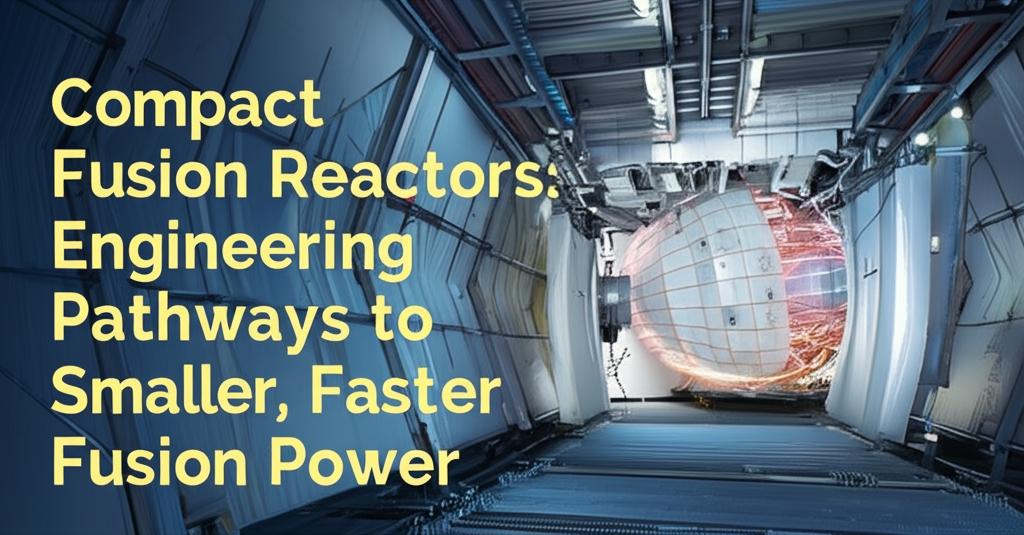The pursuit of compact fusion reactors is driven by the promise of clean, virtually limitless energy with a significantly smaller physical footprint than traditional fusion projects. These reactors, potentially fitting within a shipping container, aim to provide sustainable power for a variety of applications, including industrial, remote, and specialized uses. While still in the pre-commercial development phase, significant private investment and technological advancements are paving the way for these smaller, faster, and potentially more cost-effective fusion power solutions.
Current Status and Key DevelopmentsAs of early 2025, no compact fusion reactor has yet achieved net energy gain (producing more energy than it consumes). However, the field is dynamic, with private investment exceeding $7.1 billion globally, a substantial portion of which is flowing towards compact designs. Several companies are making notable progress:
- Commonwealth Fusion Systems (CFS): A spin-off from MIT, CFS is developing the SPARC tokamak, which utilizes high-temperature superconducting (HTS) magnets. These powerful magnets allow for a much smaller plasma volume compared to large-scale projects like ITER. SPARC aims to demonstrate net energy gain by 2026, with plans for a subsequent commercial power plant called ARC. The HTS magnet technology is considered a game-changer, enabling smaller and more efficient fusion systems.
- TAE Technologies: This company is focusing on a Field-Reversed Configuration (FRC) design. TAE recently announced a milestone with their "Norm" machine, demonstrating stable plasma using only Neutral Beam Injection (NBI), which simplifies the reactor design and could reduce costs by up to 50%.
- General Fusion: This Canadian company is pursuing Magnetized Target Fusion (MTF), where plasma is compressed by pistons within a liquid metal sphere. They aim for a compact system delivering 100-200 megawatts and are planning a demonstration plant for the late 2020s.
- Lockheed Martin Skunk Works: Their Compact Fusion Reactor (CFR) project, announced in 2014, aims to build a 100-megawatt reactor small enough to fit on a truck. Progress has been slower than initially projected, with no public demonstration as of 2025, but testing could occur within the next five years.
- nT-Tao: This company is developing a compact, scalable fusion reactor aiming for 10-20 MW of electricity, with a design about the size of a shipping container. Their approach relies on magnetic confinement and a unique plasma regime characterized by high density and super-fast heating.
The journey towards smaller, faster fusion power hinges on several key engineering pathways and technological innovations:
- Advanced Magnet Technology: High-temperature superconductors (HTS) are crucial. They enable the creation of extremely strong magnetic fields (like SPARC's 20-tesla magnets) within a compact space, which is essential for confining the superheated plasma. The development of Coated Conductors (CC) using HTS films is a significant milestone in this area.
- Innovative Confinement Concepts: Beyond traditional tokamaks and stellarators, researchers are exploring diverse magnetic confinement approaches. These include Field-Reversed Configurations (FRCs), spheromaks, and mirror machines. Inertial confinement fusion (ICF), which uses powerful lasers to compress fuel pellets, is another pathway, though primarily explored in larger facilities like the National Ignition Facility (NIF). Some companies are also investigating hybrid approaches like Magnetized Target Fusion (MTF) and Magneto-Inertial Fusion (MIF).
- Materials Science: Developing materials that can withstand the extreme heat and neutron bombardment inside a fusion reactor is a major challenge, especially for compact designs where these loads can be more concentrated. Research into advanced materials is critical for the reactor's first wall and other plasma-facing components.
- Plasma Heating and Control: Efficiently heating the plasma to fusion temperatures (hundreds of millions of degrees Celsius) and maintaining its stability are key. Techniques like Neutral Beam Injection (NBI) are being refined for use in compact systems. Overcoming plasma instabilities and density limits, such as the Greenwald limit in tokamaks, remains an active area of research.
- Tritium Breeding: Fusion reactors will need to breed their own tritium fuel from lithium. Developing reliable tritium breeding blanket technology is essential for self-sustaining fusion power.
Despite the promising advancements, significant hurdles remain:
- Achieving Sustained Fusion: Precisely confining and controlling plasma in a small volume while minimizing energy losses is technically complex.
- Development Costs: While potentially cheaper in the long run, the research and development costs for compact fusion are still substantial.
- Regulatory Frameworks: Fusion energy is relatively new from a regulatory standpoint, and clear licensing processes need to be established.
- Engineering Integration: Successfully integrating all the complex systems – magnets, vacuum vessels, heating systems, cooling systems, and power extraction – into a compact and reliable package is a massive engineering undertaking.
- Material Durability: The long-term performance of materials under intense radiation and heat flux is a critical concern that requires further research and dedicated testing facilities like IFMIF.
The drive for compact fusion reactors aligns with a "smaller, faster, cheaper" approach to development. This strategy contrasts with massive, decades-long projects like ITER, aiming for quicker learning cycles and potentially faster deployment of commercial fusion power. Advances in HTS magnets, computational modeling, and manufacturing techniques are key enablers of this paradigm shift.
Future OutlookThe development of compact fusion reactors represents a high-risk, high-reward endeavor. While timelines remain uncertain, the tangible progress being made by numerous private companies, often supported by public funding and research institutions, signals a new era in fusion energy development. Successful demonstration of net energy gain in one or more compact prototypes in the coming years could significantly accelerate the path towards commercial fusion power, offering a transformative clean energy solution for the future.

